As artificial intelligence (AI) and robotics become integral to everyday life, the demand for ethical frameworks to govern their development and deployment has intensified. From autonomous vehicles to AI healthcare systems, the stakes are high, and the consequences of neglecting ethical standards can be profound. To guide this rapidly evolving landscape, experts have identified eight foundational AI ethics pillars. These form the bedrock of responsible robotics and ethical design principles, ensuring that innovation aligns with human values.
- Transparency
Transparency is critical for building trust in AI systems. Developers must ensure that AI algorithms and robotic behaviors are understandable, auditable, and explainable. Whether it’s a healthcare diagnosis tool or an autonomous drone, users and stakeholders have the right to know how decisions are made.
Key Practices:
Use explainable AI (XAI) techniques
Document data sources and algorithmic logic
Provide clear user documentation - Accountability
Accountability ensures that human beings remain responsible for AI and robotic actions. When harm or failure occurs, there must be a clear path to determine liability—whether it rests with the developer, manufacturer, or operator.
Key Practices:
Define roles and responsibilities across the development lifecycle
Maintain traceability of decisions and actions
Establish redress mechanisms for affected users - Fairness and Non-Discrimination
Bias in AI systems can perpetuate inequality. Ethical AI and robotics must be designed to treat all individuals fairly, regardless of race, gender, age, or socio-economic status.
Key Practices:
Audit datasets for bias and representation
Train models with diverse, inclusive data
Monitor and mitigate algorithmic discrimination - Privacy and Data Governance
Respect for individual privacy is a cornerstone of ethical AI. Robotics systems that collect and process data—like home assistants or surveillance bots—must safeguard personal information through robust governance.
Key Practices:
Employ data minimization techniques
Use secure data storage and encryption
Enable user control over data usage - Safety and Security
Robotic systems must not endanger humans. From industrial robots to autonomous cars, safety protocols and rigorous testing are essential components of responsible robotics.
Key Practices:
Implement fail-safes and shutdown mechanisms
Conduct threat modeling and penetration testing
Follow industry safety standards - Human Oversight
Even the most advanced AI should augment—not replace—human judgment. Ethical design principles emphasize that systems must allow human intervention and override capabilities when necessary.
Key Practices:
Design interfaces for human-in-the-loop or on-the-loop control
Support decision-making with contextual information
Avoid full autonomy in high-stakes applications - Sustainability
Responsible robotics must consider environmental impacts. From energy consumption to lifecycle waste, sustainability is a vital but often overlooked ethical pillar.
Key Practices:
Use energy-efficient algorithms and hardware
Promote repairability and recyclability
Monitor environmental impact throughout the product lifecycle - Social and Cultural Well-being
AI and robotics should enhance societal welfare and respect cultural values. Ethical design involves engaging communities, understanding cultural contexts, and ensuring technology benefits all layers of society.
Key Practices:
Conduct impact assessments with community input
Adapt technologies for local norms and languages
Avoid cultural homogenization or technological imperialism
Conclusion: Toward a Harmonious Human-Machine Future
By grounding AI development in these eight AI ethics pillars, we move closer to creating technologies that are not only intelligent but also aligned with our deepest values. Responsible robotics isn’t just about building machines—it’s about embedding ethical design principles that prioritize humanity, justice, and long-term well-being. As we stand on the threshold of a future increasingly shaped by AI and robotics, these pillars will serve as our moral compass, ensuring innovation serves the greater good.







